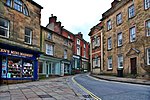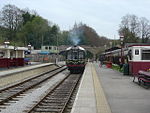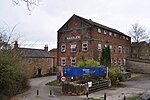St Mary's Church, Wirksworth
Anglo-Saxon artChurch of England church buildings in DerbyshireGrade I listed churches in DerbyshireUse British English from June 2013Wirksworth

St Mary the Virgin is a parish church in the Church of England in Wirksworth, Derbyshire. It is a Grade I listed building. The existing building dates mostly from the 13th–15th centuries, but notable survivals from the Anglo-Saxon period indicate a church has stood on this site since at least the 8th century AD. It was restored in 1820, then in 1870 by Sir Gilbert Scott.
Excerpt from the Wikipedia article St Mary's Church, Wirksworth (License: CC BY-SA 3.0, Authors, Images).St Mary's Church, Wirksworth
West End, Derbyshire Dales
Geographical coordinates (GPS) Address Nearby Places Show on map
Geographical coordinates (GPS)
| Latitude | Longitude |
|---|---|
| N 53.08221 ° | E -1.57404 ° |
Address
Market Place
West End
DE4 4ET Derbyshire Dales
England, United Kingdom
Open on Google Maps









